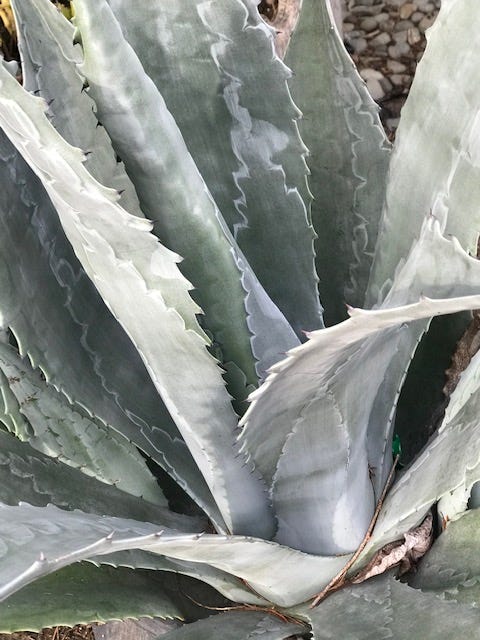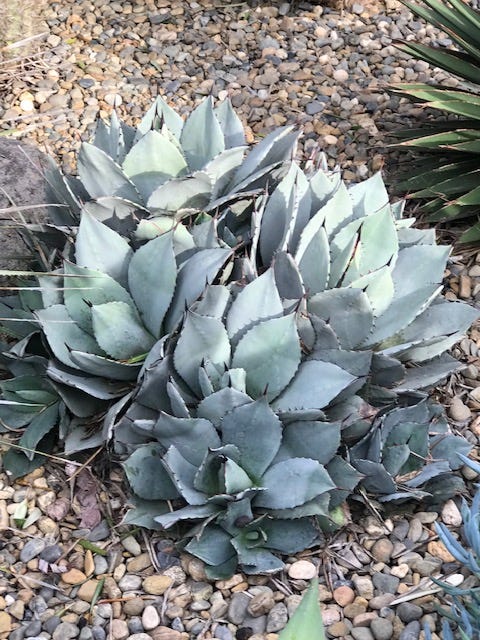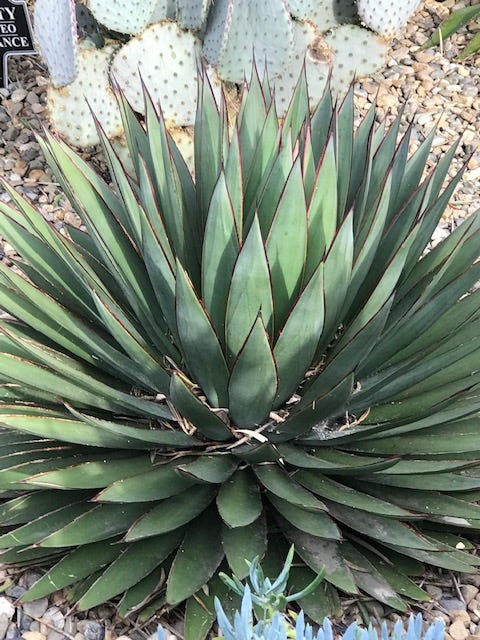NAPA VALLEY, Calif. — I enjoy wandering Napa’s neighborhoods, admiring the front yards and noting the changes in landscape gardening styles. There has been quite a metamorphosis over the decades. Many people have moved from lush English-style landscaping to water-wise gardening.
During a drought a while back it seemed as if every other person traded in a lawn for a layer of river rocks. This was an overly austere alteration, and I am happy to see that rocks and decomposed granite are being augmented with plants that are attractive and don’t need much water. One such plant is agave.
Agave (Asparagaceae) is a succulent related to asparagus and native to Mexico with more than 250 varieties being cultivated today. Agave is often confused with aloe and is sometimes called “American aloe,” but they are not the same. Agaves grow in a rosette pattern, often with spearlike leaves, and range from 18 inches to 8 feet wide.
The plants look suitable in almost any garden setting and with any sort of architecture, but they are especially harmonious with mid-century modern or high-tech settings. Some varieties, particularly the ones with embossed-looking leaves, look good with older houses.
Since they are desert plants, agaves are easy to grow and need very little water. In fact, overwatering is the source of most agaves’ problems. If they are truly parched, they will shrivel a bit but will quickly plump up when irrigated. You should wait until the soil around an agave is bone-dry before you give it water. Avoid pouring water into the agave rosette and instead water it from the side.
The agave weevil is the plant’s main pest, and it is easy to spot. The weevils are about an inch long and black, and they chew holes in the fleshy part of the agave leaf. Then they lay eggs in the holes. Weevils are more likely to attack a weakened agave, which can be caused by overwatering. If they do appear, it is best to dispose of the plant and start over. That said, I have never seen an agave weevil on any of the plants I have observed.
Propagating agave couldn’t be easier. An agave in my neighborhood has outgrown its original pot, cracking the bottom and revealing rhizomes, or “pups.” These rhizomes can be removed and planted. Spring is the best time for planting. Choose a planting medium or a site that drains well. Sandy soil or a planting mix formulated for cactus is ideal.
When you consider where to plant agave, remember that it will need at least six hours of sun a day. Also, some types have toothed or spiked leaf edges, so you may want to keep these types away from paths. You can trim those edges, taking care not to cut into the flesh of the leaves. Or you can plant them where no one will wander. Alternatively, you can grow smooth-edge agave and avoid the problem. Children and pets should not ingest agave, but given the spikes, that’s unlikely to happen anyway.
Avoid fertilizing agave. Fertilizer promotes flowering, and an agave dies off after flowering, although you can still collect the seeds and plant them.
Agave americana, the so-called century plant, got its nickname because people thought it flowered only once in a hundred years. It actually puts forth a very tall bloom after 10 years. This agave variety makes a dramatic statement in a garden, reaching 8 feet in height. It is a beautiful blue-green, with hooked spines along the edge of its leaves and a sharp spike at the tip of each leaf. Sunset’s Western Garden Book says to make sure you really want one before you plant it because they are hard to move.




The Sunset book lists agaves by size, color and “spikiness” so you can decide which to plant —or just ask at your local nursery. So many agaves grow well in Napa Valley that one could have a garden filled with nothing else and still have variety in the landscape.
Some people grow agaves in containers. If they have a particularly cold microclimate, they move the containers indoors for the season or wrap them in a thermal blanket at night.
Growing agave for tequila- and mezcal-inspired beverages is a burgeoning business now. As California’s climate continues to become hotter and drier, agave cultivation in the state should only increase. Agave is also a good firebreak plant that protects more flammable crops.
Craig Reynolds, president of the California Agave Council, a trade organization of 70 growers and a dozen craft distillers, told me he likes to grow agave at home in large ceramic pots. He has the same advice for the home gardener that he has for farmworkers: Wear long, gauntlet-style gloves when you work with agave. The sap contains calcium oxalate, an irritant that can induce a long-lasting skin rash. Of course, wearing gloves in the garden is always a good practice.
Library Talk: UC Master Gardeners of Napa County and Napa Library will host a talk on Thursday, March 7, on “Agaves — More Than Tequila and Century Plants” from 7 to 8 p.m. via Zoom. Learn more about adding these deer-proof, beautiful and low-maintenance plants to your garden. Register here to receive the free Zoom link.
Workshop: Join UC Master Gardeners of Napa County for “Spring Into Summer Vegetable Garden” on Saturday, March 9, from 10 a.m. to noon, at the University of California Cooperative Extension office, 1710 Soscol Ave., Napa. Plan your vegetable-growing for the warm weather ahead. Topics include soil prep, fertilizing, managing pests, irrigation and planting schedules. This is a hands-on workshop, and registration is required.
This workshop repeats on Saturday, March 17, from 2 to 4 p.m., at Yountville Community Center, 6516 Washington St., Yountville. To register, contact the Yountville Parks and Recreation Department.
Help Desk: The Master Gardener Help Desk is available to answer your garden questions on Mondays and Fridays from 10 a.m. until 1 p.m. at the University of California Cooperative Extension Office, 1710 Soscol Ave., Suite 4, Napa. Or send your questions to mastergardeners@countyofnapa.org. Include your name, address, phone number and a brief description. For best results attach a photo.
If today's story captured your interest, explore these related articles:
Moths and butterflies: Understanding their role and diversity in our gardens
From waterlogged lawn to sustainable oasis: transforming your backyard
Cindy Watter is a UC Master Gardener of Napa County.






So much useful information, thank you! Additional benefit of agave planting: deer eat just about anything else, but wisely leave the agaves alone...
She is a very talented writer!!!!